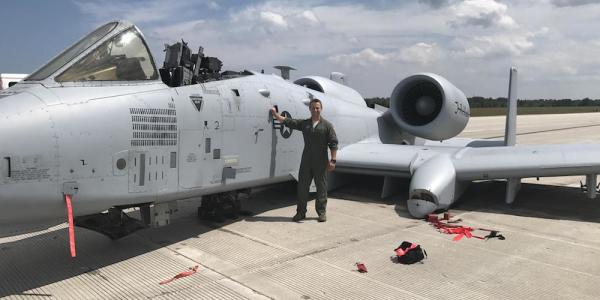A-10 Warthog Makes Dramatic Belly Landing Without Landing Gear Or Canopy After Cannon Malfunction
On July 20, Capt. Brett DeVries of the Michigan Air National Guard’s 107th Fighter Squadron was lining up his A-10...

On July 20, Capt. Brett DeVries of the Michigan Air National Guard’s 107th Fighter Squadron was lining up his A-10 Thunderbolt II “Warthog” for a routine training mission at Grayling Air Gunnery Range. As he fired his A-10’s 30mm GAU-8/A Avenger cannon during a normal strafing run, his wingman Maj. Shannon Vickers reported a brief “donut of gas” around the cockpit. Seconds later, the A-10’s massive cannon malfunctioned and the aircraft’s canopy sheared off.
Designed for ground attack missions and close air support, the A-10 has been the Air Force’s workhorse for more than 40 years. Its Avenger cannon is a force to be reckoned with, beloved for its distinctive BRRRT! sound. Luckily, A-10 pilots are encased in a titanium armor “bathtub” up to 1.5 inches thick, a feature that saved DeVries from potentially fatal injury.
Flying at around 325 knots, the wind threw DeVries’ head back into his seat, momentarily stunning him; he later said that the experience “was like someone sucker punched me.” While it was clear the A-10’s formidable cannon had failed, DeVries didn’t know the full extent of the damage to his aircraft, instinctively climbing to 2,000 feet to get out of the path of other aircraft and assess the damage.
With the rear section of his canopy gone, DeVries lowered his seat in an effort to escape the pummeling wind. His main and primary backup radios were inoperative, but he reached Vickers on his emergency backup and asked him to visually inspect his A-10. Vickers reported that several access panels near the cannon had blown wide open.

Capt. Brett DeVries (right) and his wingman Maj. Shannon Vickers, both A-10 Thunderbolt II pilots of the 107th Fighter Squadron from Selfridge Air National Guard Base, Mich. Vickers helped DeVries safely make an emergency landing July 20 at the Alpena Combat Readiness Training Center after the A-10 DeVries was flying experienced a malfunction.Photo via DoD
“To this day, I really haven’t second guessed anything,” DeVries said. “In that moment, your training kicks in. The training – that’s what saves you and your wingman.”
Vickers, along with maintenance specialists on the ground, laid out options for DeVries. Not knowing just how much damage the aircraft had sustained, Air Force personnel were concerned that the A-10’s ejector seat may not work. DeVries decided to land his stricken A-10 at the nearby Alpena Combat Readiness Training Center, which shares a runway with Alpena County Airport.
But the situation quickly took a turn for the worse when DeVries realized that the A-10’s front landing gear, positioned next to the 30mm cannon, was damaged in the incident and wouldn’t lock in place. Out of options, DeVries made the brave decision to attempt a wheels-up belly landing. For a few tense moments, DeVries made a slow, flat descent and, somehow, an impressively smooth landing, walking away from his aircraft uninjured.
Brig. Gen. John D. Slocum, 127th Wing’s commander, praised DeVries piloting skills. “He demonstrated not only superior skill as a pilot but remained calm in an extremely challenging situation,” Slocum said. “To walk away from this scenario with no injuries is a true testament to his abilities as a world-class fighter pilot.” (Slocum confirmed both pilots will be submitted for ‘appropriate recognition’ of their impressive airmanship.)
After inspections at Alpena, the damage to DeVries’ Warthog was deemed repairable, a testament to the A-10’s incredibly robust design and the aircraft will hopefully be back in the air soon.
Strangely, this isn’t the first time this has happened. Here’s video of another A-10 making a belly landing back in 1988, when a jet from the 75th Fighter Squadron, 23rd Fighter Wing suffered a similar cannon malfunction that damaged the A-10’s landing gear: